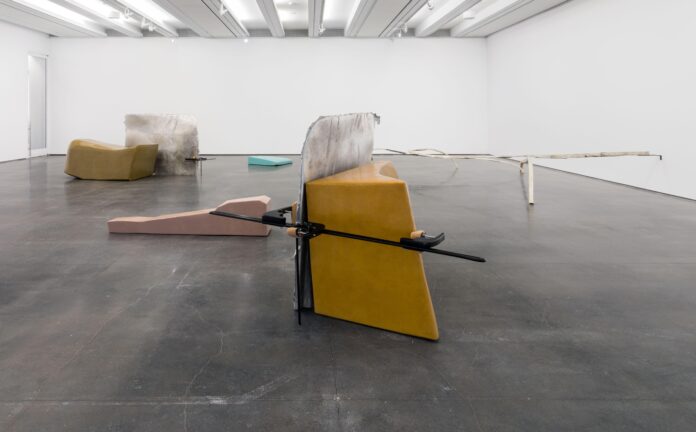In her book Garments Against Women, a rumination on the political economy of writing, poet Anne Boyer writes, “when our needs announce themselves, it is with clothing, with possessions, in literature, through dreams… that we keep ourselves alive”. To exist, in other words, is an exercise in adornment, a makerly undertaking that bucks traditional notions of taxonomy and theme.
This experiential description of process feels especially urgent in the context of Jupon de Corps (until 22 October), Iranian German artist Nairy Baghramian’s solo show at the Aspen Art Museum (AAM), which gathers several bodies of her work made over the last decade. The spare, somatic exhibition borrows its title from the French phrase for “petticoat”, etymologically anteceded by the word for a tunic worn to protect the skin from armor in the late 13th century.
“A petticoat is a very gentle type of garment, but it still is a boundary,” says Stella Bottai, AAM’s curator-at-large. “It’s something that creates a conversation around hierarchies and bodies, public and private, and the title leads us into this concept of intimacy that is present in all of the sculptures.”

Installation image of Nairy Baghramian: Jupon de Corps at the Aspen Art Museum Daniel Pérez, Aspen Art Museum
Unlike Boyer’s conception of need, Baghramian’s art does not announce itself—each piece sits, hangs, leans or lounges with the frankness of an archeological ruin. The work on display shares a visual etymology with sculptors of the 1960s and 70s whose work is often presented through a feminist lens, like Eve Hesse or Lynda Benglis, a canon filled with material articulations of embodied affect, simultaneously quotidian and grotesque.
That art historical affinity is made clear through Baghramian’s creative diction. Whether in wax or resin or arachnid clambers of cast aluminium, she conveys vitality through mulish bodybuilding, both dressing and undressing in slick spatial interventions.
“You have to give the material the opportunity to open itself,” the artist explained in a public conversation with Serpentine Galleries artistic director Hans Ulrich Obrist and AAM director Nicola Lees earlier this summer. “Art itself, if you start defining it, loses so much complexity. That is why I struggle with interviews—you have to define, you have to defend.”

Nairy Baghramian, Scratching the Back: Drift (Tortillon orange) (2023), for The Facade Commission: Nairy Baghramian, Scratching the Back, Metropolitan Museum of Art, New York Courtesy the artist, kurimanzutto, and Marian Goodman Gallery. Image credit: The Metropolitan Museum of Art, Photo by Bruce Schwarz
Baghramian’s work is hard to write about, as it should be. Over her three-decade career—which includes two showcases at the Venice Biennale, the 2022 Nasher Prize and a series of new commissions for the Metropolitan Museum of Art’s façade—she has embraced a poetics of refusal, eschewing easy soundbites and readily-understood identity politics in favor of something inutterable, but more profound. Born in Iran in 1971, she fled to Berlin with her family in 1984, as the Islamic Revolution was taking hold in her home country.
“I don’t really have a native language,” she said. “I speak four languages, none of them well. I’m translating all the time.” Her sensitivity to communication’s shortcomings, what Afro-Carribean poet M. NourbeSe Philip calls the “foreign anguish” of speech, lends Baghramian’s work a concertedly post-structuralist thrust, although critical theory feels somewhat at odds with the eerie beauty she cultivates in Jupon de Corps.

Installation image of Nairy Baghramian: Jupon de Corps at the Aspen Art Museum Daniel Pérez, Aspen Art Museum
In B 75, BH, Mod. NB, Ref. CO, MM (2012)—a reference to Claes Oldenburg’s Ghost Wardrobe (for M. M.) (1967)—concrete hangers bear the negligible weight of eerily cartoonish rubber spirals, unraveling into the shape of a bright bra. The piece feels as poignant as it does goofy, a bright-colored totem to visceral absence. In the exhibition, B 75 is flanked by a cluster of large styrofoam slabs, clamped with awkward fervour against translucent shields of wax. Sturdy in presence yet elementally fragile, this material graveyard operates with a coyness that both entrances and repels the viewer, resisting any simplistic assignment of meaning while insisting on viewer interaction or, more directly, on care.
Upstairs, pallid phallic figures both languish inside and dare to escape a human-sized glass vitrine, a heart-rending tableau that finds timelessness through its immediacy. “The body” is everywhere in this show. Take the industrially scaled spinal column segmenting the gallery floor (French Curve, 2014), or the vivisected dog bone, Treat (2016), that lies on the ground like a felled corpse, awaiting some giant canine’s maw. There’s humour here, or a relationship with humour that doesn’t erase the scaffolding of sadness required for humour to happen.

Installation image of Nairy Baghramian: Jupon de Corps at the Aspen Art Museum Daniel Pérez, Aspen Art Museum
“I felt sculpture was rejected,” Bahgramian said, recalling the earlier years of her career. “I always feel for what is rejected.” Jupon de Corps catalogues objects that bob in the wake of interruption—disturbed and traumatised, but brimming with interiority. “Chance is the biggest tool I use,” she added. The results are haunting, gorgeous, and honest, a truly refreshing combination.
Paired with an exhibition of brooding, risqué paintings by up-and-coming art world darling Florian Krewer in the museum’s downstairs gallery (until 24 September), Jupon de Corps presents a conceptual challenge to its luxurious mountain town setting. Lees, whose background includes a stint as senior curator at London’s Serpentine Galleries and a directorial turn at New York University’s 80WSE space, is undeterred, calling Bahgramian “the most important sculptor of her generation”.
Plus, a little bit of friction is part of the point. “I don’t believe in any work with no struggle involved,” Baghramian said. “That’s just copying yourself.”
- Nairy Baghramian: Jupon de Corps, until 22 October, Aspen Art Museum, Aspen, Colorado
- Nairy Baghramian: Scratching the Back, until 28 May 2024, Metropolitan Museum of Art, New York

























